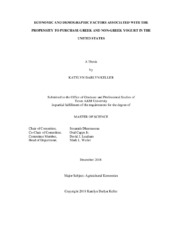| dc.description.abstract | Health has become an increasing concern for many Americans. Producers and manufactures of food products in response are creating healthier options. As a result, there are many types of healthy food products available for consumers today. One of the most commonly desired food products is yogurt. In this light, the objective of this research is to determine socio-economic and demographic factors affecting the propensity of purchasing conventional (non-Greek) yogurt and Greek yogurt with and without reference to brands. To accomplish this objective, the study uses Nielsen Homescan Panel data concerning 61,380 households for the 2015 calendar year. In all, twelve different probit models for non-Greek and Greek yogurt were developed and estimated. The economic and socio-demographic factors considered were prices, household income, household size, region, age and presence of children, race, education of the household head, and age of the household head.
Income and price had an effect on every profile for the purchase of any type of yogurt. The statistically significant socio-demographic variables varied for each probit model. Model validation using expectation prediction-success tables was conducted, and probability resolution (sorting) and resolution graphs were constructed. The results showed reasonable sensitivity and specificity values for all twelve probit models. As well, all twelve models showed some degree of sorting power.
This study allows manufacturers and retailers the opportunity to reach households not yet purchasing yogurt/ Greek yogurt as well as to better understand households that are purchasing yogurt/ Greek yogurt. Further research could include examination of drinkable yogurt as well as consideration of additional factors, such as ethnicity and advertising. Next iii
steps should include the use of Tobit models or Heckman sample selection models to discern conditional and unconditional drivers of the quantities purchased of the respective yogurt types considered.
. | en |


